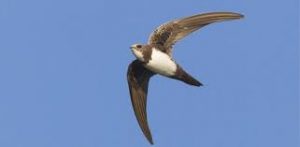Would you spend most of your life walking? Obviously not, but this bird lives in flight. It is called Swift and it is a small European migrator bird that seems to be mold to stay in the air. Its peculiarity? It can fly for 10 months non-stop.
 This fact has been confirmed by a research made by the biologist Anders Hendenstrom, from the University of Lund (Sweden). In his studies he used a detector that weights 1.1 grams and includes an accelerometer and a light sensor, used to define the position of the bird during the flight.
This fact has been confirmed by a research made by the biologist Anders Hendenstrom, from the University of Lund (Sweden). In his studies he used a detector that weights 1.1 grams and includes an accelerometer and a light sensor, used to define the position of the bird during the flight.
He has followed 19 Swifts day and night and he saw that three of them literally never laid on the ground, the others laid rarely and only for a few minute. These birds interrupt the flight just when they have to build their nests and to lay and sit on eggs. The rest of the activities, as sleeping, eating and reproducing, is done in the air.
So how can they sleep if they fly all the time? The answer is easy: they sleep while they are flying. This affirmation is proved by a research that demonstrates that these birds are able to have both a unihemispheric sleep and to maintain the abilities to fly and to orient also in REM phase, a stage of the sleep that involves the complete loss of muscular tone.
This deduction is the result of a study made by Niels Rattenborg of the Max Planck Institute for Ornithology (Germany), who created, with other colleagues, an engine able to monitor the electric activity of birds brain during the flight. The result is that during the day the birds stayed awake, while when the sun went down and they were at a high altitude, they showed in different minutes periods of sleep at slow waves, sometimes in one hemisphere (especially during the flight handlings), other times in both.
The birds have the aerodynamic control also when the brain is totally asleep. From this monitoring the scientists could understand that swings need few minutes of sleep per day (just 42 minutes).
Another fascinating aspect of the life of these birds is that swifts create relationships with a partner that last forever.
During the migration the Swift can lose his partner but at the end of this period the two “overs” find each other and rebuild their abandoned shelter.
Quite busy life, don’t you think so?
Francesca Ferraro, 2B Ls



